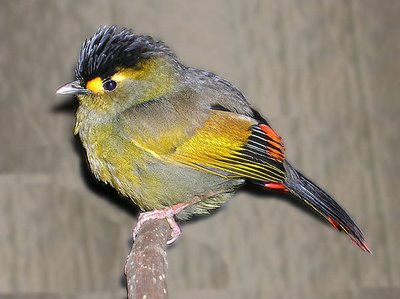
Tuesday, September 12, 2006
New Species: Bugun Liocichla
A beautiful new species has been discovered in India. The new species is a liocichla, related to babblers. An astronomer first saw the species in 1995 but could not identify it with existing field guides. He did not see it again for another decade. A colleague suggested that it was an Emei Shan Liocichla (Liocichla omeiensis), a species that occurs 1,000 km away in southwest China. In May 2006, he caught one bird. Measurements taken from that bird, as well as differences in plumage and calls, indicated that this liocichla was a separate species. It has been designated Bugun Liocichla (Liocichla bugunorum) after the local Bugun tribe that owns the forest where most sightings were made.


Friday, September 08, 2006
Upcoming Field Trip to Rock Creek Park
DC Audubon field trip announcement: mark your calendars.
Next Sunday, Sept. 17, join DC Audubon's annual field trip to Rock Creek Park in search of Fall migrants. We'll be looking for those confusing Fall warblers, of course, but not neglecting any others. Meet by the Rock Creek Nature Center at 7 A.M. (5200 Glover Rd., N.W., about 1/4 mile south of the intersection of Glover and Military Roads). The Ridge and Maintenance Yard areas will get most of our attention, but we may visit others (within walking distance from the Center) at the leader's discretion. We should finish up by 11. Besides the trusty binocs & field guide, I recommend insect repellant, sunscreen, and waterproof footwear (not a bad idea to bring water & snacks as well).
Please RSVP to the leader, Paul DeAnna by telephone in the evenings after 6pm (202) 544-2680. Please include a phone number where you can be reached the evening before the trip, just in case a weather postponement becomes necessary. If you can offer a ride to a non-driving birder in your neighborhood, please let me know the general area you're coming from. I'll do what I can to put those offering rides in touch with those needing them. Detailed driving directions are available on the Park's website.
Rock Creek is also accessible by public transportation. Take the E2 bus to the intersection of Miltary Road and Glover Road (a.k.a. Oregon Ave), NW. From there follow the path at the southeast corner of the intersection to the Nature Center.
An announcement of this field trip is also posted on our website.
Next Sunday, Sept. 17, join DC Audubon's annual field trip to Rock Creek Park in search of Fall migrants. We'll be looking for those confusing Fall warblers, of course, but not neglecting any others. Meet by the Rock Creek Nature Center at 7 A.M. (5200 Glover Rd., N.W., about 1/4 mile south of the intersection of Glover and Military Roads). The Ridge and Maintenance Yard areas will get most of our attention, but we may visit others (within walking distance from the Center) at the leader's discretion. We should finish up by 11. Besides the trusty binocs & field guide, I recommend insect repellant, sunscreen, and waterproof footwear (not a bad idea to bring water & snacks as well).
Please RSVP to the leader, Paul DeAnna by telephone in the evenings after 6pm (202) 544-2680. Please include a phone number where you can be reached the evening before the trip, just in case a weather postponement becomes necessary. If you can offer a ride to a non-driving birder in your neighborhood, please let me know the general area you're coming from. I'll do what I can to put those offering rides in touch with those needing them. Detailed driving directions are available on the Park's website.
Rock Creek is also accessible by public transportation. Take the E2 bus to the intersection of Miltary Road and Glover Road (a.k.a. Oregon Ave), NW. From there follow the path at the southeast corner of the intersection to the Nature Center.
An announcement of this field trip is also posted on our website.
Thursday, September 07, 2006
A Swift Night Out
If you know the location of a chimney swift roost, consider participating in A Swift Night Out. This project was begun to increase public awareness of chimney swifts and to support their conservation. There are two weekend counts this summer, one in August (already passed) and one this weekend. Here are the directions:
Chimney swifts became common in urban areas because of the availability of chimneys and other vertical structures for nesting. However, in recent years the population has declined as chimney construction has changed to discourage nesting. Swifts benefit city residents by consuming large number of insects every day. For more information on chimney swifts, see ChimneySwifts.org.
Here is how it works: Keep your eyes to the skies at dusk in late July and watch for areas where swifts are feeding. Look for a tall shaft, chimney or similar structure to locate where Chimney Swifts (central to east coast) or Vaux's Swift (Pacific coast) go to roost in your area.See here for contact information and results from previous years.
This year, on one night over the weekend of August 11, 12, 13, and / or September 8, 9, 10 observe the roost starting about 30 minutes before dusk and estimate the number of swifts that enter. When you have your number, contact us with your results. That's all there is to it!
Please include the following information:
- Number of swifts counted
- Time (and time zone)
- Date
- Location
- Address: city, state/province
- Broad description of the site, e.g. school, warehouse, residence, Chimney Swift Tower, etc.
- Weather conditions may also be reported.
Chimney swifts became common in urban areas because of the availability of chimneys and other vertical structures for nesting. However, in recent years the population has declined as chimney construction has changed to discourage nesting. Swifts benefit city residents by consuming large number of insects every day. For more information on chimney swifts, see ChimneySwifts.org.
Subscribe to:
Comments (Atom)
